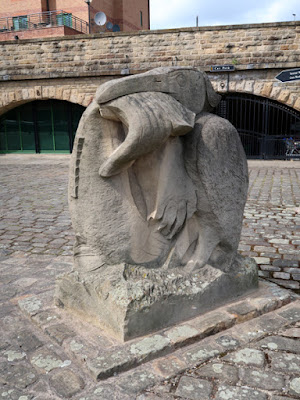On the Sunday following the recce for the Sheffield U3A Geology Group field trip to Ashover, I decided to spend another afternoon exploring the industrial east end of Sheffield. As usual, I had prepared a list of buildings to photograph for the British Listed Buildings website and, having alighted from the X54 bus at Cricket Inn Road, I headed down to the Sheffield and Tinsley Canal.
Firstly taking a photo of the brick built warehouse of G.S. Dilley & Sons, which I had misidentified during my previous walk along the canal, I walked along the towpath until I reached the stone and brick built Bacon Lane canal bridge (c1819).
According to the Historic England listing, this was probably designed by William Chapman, who was also thought to be responsible for the Cadman Street canal bridge. The weathered muddy brown sandstone used for the external facing contrasts with the coarse grey/orange sandstone used for the voussoirs, string course and coping stones and also with the greyish fine/medium grained stone in the canal side wall to the west of the bridge.
During my previous walk around the area between the canal and the River Don, to the east of the canal basin, I encountered many bridges and retaining walls where various different sandstones have been used. I thought that the coarse gritty sandstones are probably from the Chatsworth Grit in the Rivelin Valley, with the walling stone likely to be from the Parkgate Rock at the Park Hill quarries or the Silkstone Rock from the Clay Wood quarries.
Continuing with my walk, I had a quick look at Washford Bridge, which takes the Attercliffe Road across the River Don. Viewed from some distance, I could only see that it is built with large blocks of a massive light brown/orange sandstone, which looks quite similar to the stone that I had seen in the Wicker Viaduct.
After stopping to quickly photograph the brick built crucible steel works and the Baltic Works on Effingham Road, I carried on to No. 5 Birch Road (c1805), a former house for the manager of the Attercliffe steam corn mill that is built with ashlar sandstone.
Although the roads have now been resurfaced, I could see several places on Birch Road and Bessemer Road where the tarmac had been worn off to reveal various different granites, which have been used for road setts.
In several residential areas in Sheffield, I had encountered setts made from gritty sandstone found in the Chatsworth Grit, Crawshaw Sandstone and Loxley Edge Rock in the north-west of the city; however, the industrial east end grew up around the Northern Midland Railway and the Manchester, Sheffield and Lincolnshire Railway, which enabled granite to be brought in from all over the UK.
The painted detailing to the corner and entrance of the former offices (1911) of Jonas and Colver Ltd caught my eye. They operated the Novo Steel Works in Attercliffe between 1913 and 1935, but the building is now occupied by Special Quality Alloys Ltd, which is one of the specialist industries that still exist in this part of Sheffield.
Making my way along East Coast Road to the River Don, my next stop was Sanderson’s Weir, where gritstone, along with large sandstone boulders, has been used for the main structure and also for the fish pass, which is one of several that have been built along the River Don – leading to the return of salmon to Sheffield for the first time in 200 years.
Since the closure of the vast majority of the steel works that once severely polluted the River Don, the river has been cleaned up considerably and, according to the excellent Five Weirs Walk information panel, many other species of fish and invertebrates have returned, attracting herons, kingfishers and otters.
Passing the Pluto Works and arriving at Savile Street East, I quickly photographed a few buildings that formed part of the vast Firth-Brown works, which pioneered the manufacture of cheap bulk steel in Britain, but it was only the gateway (c1900) to the Siemens melting shop at the Norfolk Works that was of interest to this Language of Stone Blog.
Finishing my photographic task of the day at the Brown-Firth Laboratories on Princess Street, I headed back towards Sheffield where I encountered a section of viaduct and various bridges, which carry a branch of the Northern Midland Railway that was diverted from its original terminus at the Wicker to connect with the Sheffield Midland railway station (1870).
Passing the Ketton Cement Store, which I will describe in my next post, I dropped into Tesco to do a bit of essential shopping before finishing my walk at Victoria Quays, which had been extremely busy when I last visited a few weeks previously. Here, I took a few more photos of the Heron and Fish sculpture by Vega Bermejo, the converted coal staithes and the Chatsworth Grit quoins to the Terminal Warehouse, before catching my bus back to Treeton from Sheffield Interchange.















Lovely visit, thanks again.
ReplyDeleteThanks Chris.
ReplyDelete